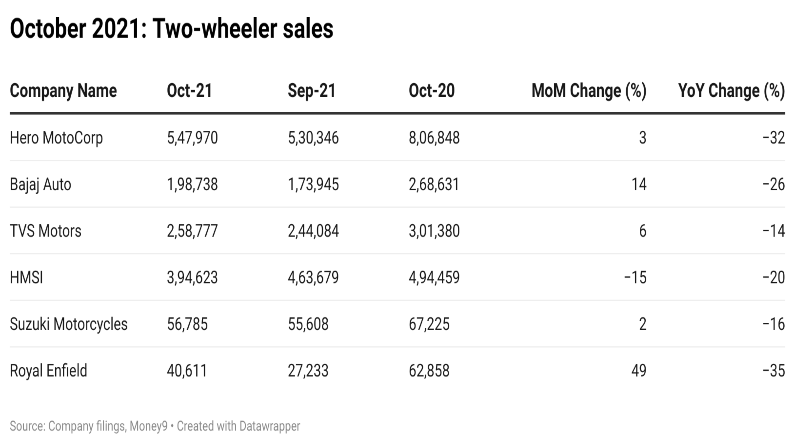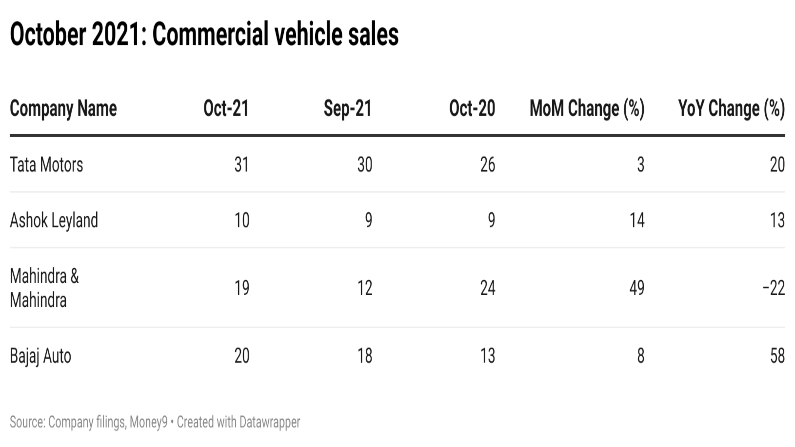October 2021 auto sales a mixed bag led by supply chain shortage, slow rural demand
Sales of passenger vehicles, which comprise cars, SUVs and vans, dipped 22% in October due to supply-side constraints.

The month of October is usually a busy one for the automobiles industry due to festivals coinciding in the month. However, the month of October 2021 was different from other years as auto makers were hit by unprecedented supply chain disruptions, fuel price hikes, increase in input costs and consequent vehicle price rise, and the economic slowdown after the COVID second wave marred the September and October sales.
Passenger vehicles
The demand for passenger vehicles remained buoyant but delivers were slow as most car models remain in the waiting list and even though wholesales for some automakers were better than September 2021, they remained in the red on a year-on-year basis for the market leaders.

The number of passenger vehicles sold by various OEMs.
Barring MG Motors, all other OEMs (original equipment manufacturers) saw a growth on a monthly basis. However, on annual basis, the performance lagged compared to the previous year despite the low base of pandemic primarily led by supply chain constraints.
2-wheelers

The number of two-wheelers sold by various OEMs.
Two-wheelers remained in red on a YoY basis as sales were down in double digits across the segment. However, on a sequential basis two-wheeler OEMs reported a rise in dispatches in October this year over the previous month of September, except for HMSI.
Commercial vehicles

The number of commercial vehicles sold by various OEMs.
Sales of Commercial vehicles (CV) in October 2021 were in the green, except for Mahindra & Mahindra which posted a 21% decline in year-on-year sales. While on sequential basis all OEMs posted a growth.
Chip shortage
Forced production cuts due to semiconductor shortage has led to dip in sales of passenger vehicles in the month of October 2021. Sales of passenger vehicles, which comprise cars, SUVs and vans, dipped 22% in October. Dealers are sitting on an order book of over 500,000 units, with the waiting period for certain vehicle models stretching to over six months.
Maruti Suzuki termed current supply chain situation as quite dynamic and said it expects its total vehicle production volume across its facilities to be around 85% of the normal production.
While analysts on the street expect semiconductor shortages to continue at least for the next 5-6 months.
No discounts
Discounts and benefits on buying a new car are now a thing of the past now. According to data compiled by JATO Dynamics, a supplier of auto business intelligence showed that the average discount level has shrunk more than 50% since 2019 with SUV discounts dropping from Rs 47,000 to Rs 15,000, while small car discounts are down from Rs 43,600 to Rs 13,000 as supply problems plague the market due to semiconductor shortage. This has resulted in customers not getting the cars they want, and not wanting the cars they get.
Reduced demand
At one end people are lining up to buy passenger vehicles on the other end the demand for commuter motorcycles is tepid. Two-wheeler retailing may have declined about a quarter through the festive season led by due high vehicle acquisition costs and rising fuel prices, especially in rural India.
Download Money9 App for the latest updates on Personal Finance.
Related
- सरकार ने GST दरों में कमी के बाद पैकेजिंग नियमों को आसान बनाया
- GST दर सुधार पर परिषद की बैठक शुरू, तेदेपा का समर्थन, विपक्षी दलों ने राजस्व संरक्षण की मांग की
- एससीओ शिखर सम्मेलन में विकास बैंक की स्थापना को मंजूरी: चीनी विदेश मंत्री
- फिच रेटिंग्स ने भारत की साख को स्थिर परिदृश्य के साथ ‘बीबीबी’ पर रखा बरकरार
- कृषि, ग्रामीण श्रमिकों के लिए खुदरा मुद्रास्फीति जुलाई में घटकर 0.77 प्रतिशत एवं 1.01 प्रतिशत
- मंत्रिसमूह ने केंद्र के दो GST स्लैब के प्रस्ताव को स्वीकार किया

